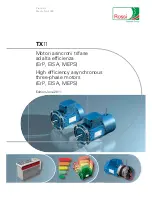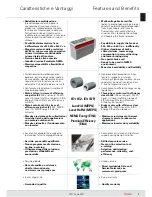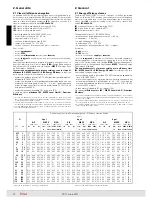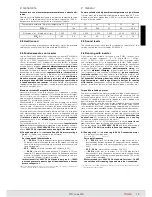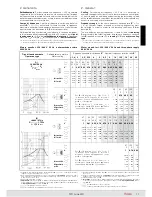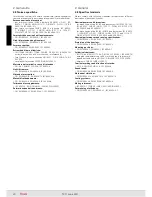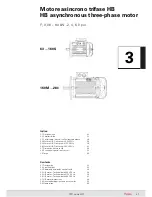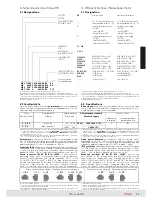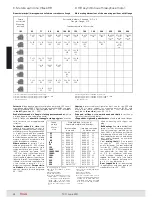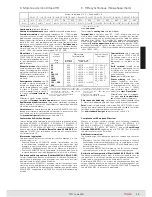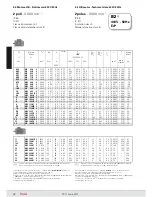
14
TX11 June 2011
Massimo lavoro di attrito per ogni frenatura
W
f
Nel caso di un numero elevato di frenature/h (
z
0,2
z
0
) o di inerzie
applicate molto elevate (
J
10
J
0
) è necessario verificare che il lavo-
ro di attrito per ogni frenatura non superi il massimo valore ammesso
W
fmax
indicato ai p.ti 4.4, 5.4, 6.4 in funzione della frequenza di frena-
tura (per valori intermedi di frequenza impiegare il valore più basso
o, all’occorrenza, interpolare):
per il calcolo di
f
ved. sotto.
Tempo di avviamento
t
a
e angolo di rotazione del motore
a
t
a
=
(
J
0
+
J
) ·
n
N
9,55 · (
M
S
-
M
richiesto
)
[s]
a
=
t
a
·
n
N
19,1
[rad]
Per calcoli più accurati sostituire a
M
S
il momento medio accelerante, normalmente
M
a
≈
0,85 ·
M
S
.
Tempo di frenatura
t
f
e angolo di rotazione del motore
f
t
f
=
(
J
0
+
J
) · n
N
9,55 · (
M
f
+
M
richiesto
) [s]
f
=
t
f
·
n
N
19,1
[rad]
Se
M
richiesto
tende a trainare il motore (esempio carico sospeso) intro-
durre nelle formule un numero negativo.
La ripetitività di frenatura al variare della temperatura del freno e
dello stato di usura della guarnizione di attrito è, entro i limiti normali
del traferro e dell’umidità ambiente e con adeguata apparecchiatura
elettrica, circa
±
0,1 ·
f
.
Durata della guarnizione di attrito
Orientativamente il numero di
frenature tra due registrazioni
del
traferro vale:
per il calcolo della
periodicità di registrazione del traferro
, il valore
di
C
è dato dalla differenza tra i valori max e min del traferro; per il
calcolo della
durata totale del disco freno
, il valore
C
è dato dal
valore massimo di consumo
C
max
(ved. p.ti 4.4, 5.4, 6.4).
Maximum work of friction for each braking
W
f
In case of a high number of brakings/h (
z
0,2
z
0
) or very high iner-
tiae applied (
J
10
J
0
) it is necessary to verify that work of friction
for each braking does not exceed maximum permissible value of
W
fmax
as shown at points 4.4, 5.4, 6.4 according to frequency of
braking (for intermediate values of frequency apply the lowest value
and interpolate, if necessary):
for the calculation of
f
see below.
Starting time
t
a
and motor rotation angle
a
t
a
=
(
J
0
+
J
) · n
N
9,55 · (
M
S
-
M
required
)
[s]
a
=
t
a
·
n
N
19,1
[rad]
For more accurate calculations replace
M
S
with a mean acceleration torque, usually
M
a
≈
0,85 ·
M
S
.
Braking time
t
f
and motor rotation angle
f
t
f
=
(
J
0
+
J
) ·
n
N
9,55 · (
M
f
+
M
required
)
[s]
f
=
t
f
· n
N
19,1
[rad]
If
M
required
tends to pull the motor (e.g. overhung load) introduce a
negative number in the formulae.
Assuming a regular air-gap and ambient humidity and utilising suita-
ble electrical equipment, repetition of the braking action, as affected
by variaton in temperature of the brake and by the state of wear of
friction surface, is approx.
±
0,1 ·
f
.
Duration of friction surface
As a guide, the number of
brakings
permissible
between successi-
ve adjustments
of the air-gap is given by the formula:
for the calculation of
periodical air-gap adjustment
,
C
value is
given by the difference between max and min values of the air-gap;
for
total brake disk life calculation
,
C
value is given by the maxi-
mum wear value
C
max
(see points 4.4, 5.4, 6.4).
W
fmax
M
f
·
f
[J]
W
fmax
M
f
·
f
[J]
W
1
·
C
· 10
6
M
f
·
f
W
1
·
C
· 10
6
M
f
·
f
2.4 Variazioni delle caratteristiche nominali
Alimentazione diversa dai valori nominali
Le caratteristiche funzionali di un motore trifase
alimentato a tensio-
ne e/o frequenza diverse
da quelle nominali di avvolgimento si pos-
sono ottenere approssimativamente moltiplicando i valori nominali
dei p.ti 4.5, 5.5, 6.5 per i fattori correttivi indicati in tabella validi per
la sola parte motore (la targa riporta comunque i dati nominali di
av volgimento):
2.4 Variations of nominal specifications
Supply differs from nominal values
Functional specifications of a three-phase motor
supplied at vol-
tage and/or frequency differing
from the nominal ones can be
obtained approximately by multiplying nominal data of points 4.5,
5.5, 6.5 by correction factors stated in the table valid for the motor
only (however, the name plate contains the nominal winding data):
Alimentazione nominale
Alimentazione alternativa
2)
Fattori moltiplicativi dei valori di catalogo
Nominal supply
Alternative supply
2)
Multiplicative factors of catalog value
Frequenza [Hz] Tensione [V]
Frequency [Hz]
Voltage [V]
P
N
n
N
I
N
M
N
I
S
M
S
,
M
max
230 Y400 V 50 Hz
50
220 Y380
1
,0
1
0,95
1,05
1
0,96
0,9
2
240 Y415
1
,0
1
0,95
1,05
1
1,04
1,08
60
220 Y380
1)
1
,0
1,19
0,95
1,05
0,83
0,79
0,63
255 Y440
1) 2)
1,1
1,2
0,95
1
0,92
0,92
0,84
265 Y460
2)
1,15÷1,1
3)
1,2
0,95
1,05
0,96 ÷ 0,92
3)
0,96
0,92
277 Y480
2)
1,2
1
÷1,15
4)
1,2
1
1
,09
÷ 0,96
4)
1
1
400 V 50 Hz
50
380
1
,0
1
0,95
1,05
1
0,96
0,9
2
415
1
,0
1
0,95
1,05
1
1,04
1,08
60
380
1)
1
,0
1,19
0,95
1,05
0,83
0,79
0,63
440
1) 2)
1,1
1,2
0,95
1
0,92
0,92
0,84
460
2)
1,15÷1,1
3)
1,2
0,95
1,05
0,96 ÷ 0,92
3)
0,96
0,92
480
2)
1,2
1
÷1,15
4)
1,2
1
1
,01
÷ 0,96
4)
1
1
1) Fino alla grandezza 132MB, il motore normale può funzionare anche con questo tipo di
alimentazione purché si accettino sovratemperature superiori, non si abbiano avviamenti
a pieno carico e la richiesta di potenza non sia esasperata (
P
N
di tabella); non targato per
questo tipo di alimentazione.
2) Per il valore di tensione del freno, ved. cap. 4.9 (1), 5.9 (1).
3) Valore valido per grandezza
160M.
4) Valore valido per grandezze 160L 4, 180M 4, 200L 4 e 250M 4.
1) Up to size 132MB, standard motor can also operate with this supply provided that
higher temperature rise values are acceptable without on-load starts and that the power
requirement is not unduly demanding
(P
N
in the table); this supply is not shown on
motor name plate.
2)
For brake voltage value, see ch. 4.9 (1), 5.9 (1).
3) Value valid for size
160M.
4) Value valid for sizes 160L 4, 180M 4, 200L 4 and 250M 4.
2. Generalità
2. General
Summary of Contents for TX11 Series
Page 2: ......
Page 203: ...203 TX11 June 2011...

